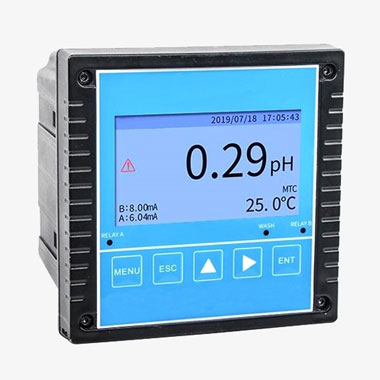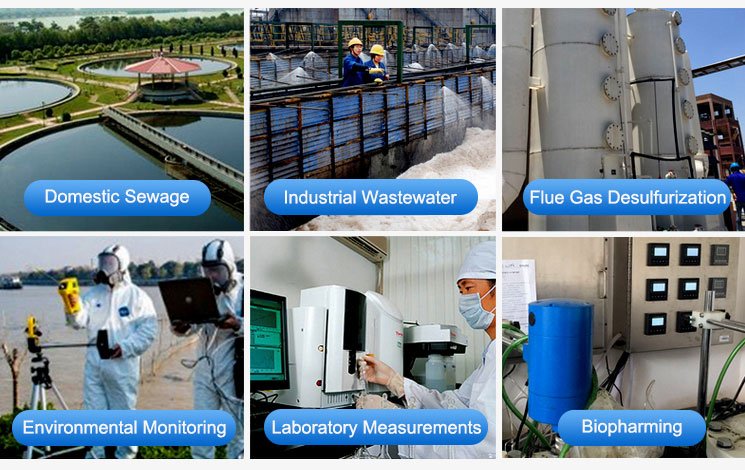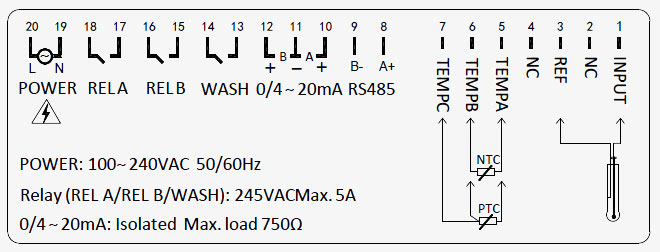Digital pH/ORP meter has good anti-interference, manual/automatic temperature compensation function, which can be matched with various pH electrodes or ORP electrodes to realize online testing and monitoring of pH of sewage, corrosive solution, liquid medicine, beer, drinking water, food, etc.

Watchdog protection system, strong anti-interference ability
- 2.4 inch LCD display.
- Good anti-interference performance.
- Manual/automatic temperature compensation.
- User settings: Language, buzzer, LCD backlight, password, pH/ORP.
- electrode, manual/automatic temperature compensation, pH/ORP calibration, pH/ORP/temperature modification, pH/ORP high/low alarm, output signal 4-20mA and RS485, etc.
- Internal industrial watchdog insures pH meter doesn't crash.
Application
Digital pH/ORP meter is widely used in the continuous testing and monitoring of pH, ORP and temperature in thermal power, chemical fertilizer, metallurgy, environmental protection, pharmaceutical, biochemical, food, drinking water, etc.

| Model | SISCO-PHCR-PH8.0 |
| Weight | 1kg |
| Dimension | 144*144*115mm (H*W*D) with hole size 138*138mm |
| Display | 4.3 inch LCD color screen |
| Measuring range | pH/Antimony: -2.00 ~ +16.00pH ORP: -2000 ~ +2000mV Temperature: -10.0 ~ +130.0℃ |
| Accuracy | pH:±0.02pH Antimony: ±0.2pH |
| ORP: ±2mV | |
| Temperature: NTC10K: ±0.3℃ (-10~+60℃), ±2.0℃ (60~130℃) PT1000/PT100: ±0.3℃ |
|
| Input impedance | ≥1012Ω |
| Resolution | pH/Antimony: 0.01pH |
| ORP: 1mV | |
| Temperature range | 0~100℃ (NTC 10K, accuracy: ±0.5℃) |
| Repeatability | 0.02pH |
| Temperature compensation | Compensation mode: Manual/Automatic |
| Compensation curve: Linear, Acid, Base, Pure | |
| Record | 100 sets, recording interval can be set through configuration, the recording method is FIFO. |
| Output signal * | Isolated 4-20mA signal (error: ±0.2%, under maximum loop resistance 750Ω), default 1 * 4-20mA output, optional 2 * 4-20mA outputs |
| Communication function | RS485 with standard MODBUS-RTU (Now RS485 software is free.) |
| Power supply | AC: 85~265V, 50Hz/60Hz |
| DC: 21.6~26.4V | |
| Alarm relay delay | 0~9999 seconds, adjustable |
| Protection class | IP66 |
| Operating temperature | Temperature: 0~60℃ |
| Relative Humidity: 10~85%RH (no condensing) | |
| Storage condition | Temperature: -15~+65℃ Relative Humidity: 5~95%RH (no condensing) |
| Automatic cleaning * | Manually clean, set cleaning interval |
The pH meter and pH/ORP electrode selection
| pH meter | pH/ORP electrode | Industry | Temperature range | Advantage |
| SISCO-PHCR-PH8.0 | Combination pH electrode | Sewage disposal | 0-60℃ (32-140℉) | Combination electrode has automatic temperature compensation function, suitable for occasions with large temperature fluctuations. |
| Pure water pH electrode | Drinking water | 0-60℃ (32-140℉) | The pH calomel electrode can be used in strong acid or alkali. | |
| PTFE pH electrode | Chemical | 0-60℃ (32-140℉) | The electrode shell is made of PTFE, suitable for corrosive solution (strong acid or alkali), has longer life in harsh environments. | |
| pH glass electrode | Sewage disposal/food | 0-95℃ (32-203℉) | Direct lead, double-layer glasses. | |
| Desulfurization pH electrode | Desulfurization | 0-60℃ (32-140℉) | Flat electrode, strong anti-pollution ability and longer life | |
| High temperature/sterilization pH electrode | Food | -5℃-130℃ (23-266℉) | The electrode can withstand high temperature of 0-130℃, suitable for occasions of high temperature sterilization in pharmaceutical factories, breweries, etc. | |
| High Pressure pH electrode | Laboratory | -5℃-130℃ (23-266℉) | Its linearity and accuracy are higher than all above electrodes. |
Wiring diagram:

Definition of the ports
- INPUT: Measuring terminal of the electrode
- REF: Reference terminal of the electrode
- NC: Undefined
- A: Temperature compensation terminal A, connect to NTC 10K or PT1000
- B: Temperature compensation terminal B, connect to NTC 10K or PT1000
- C: Temperature compensation terminal C, connect to 3-wire PT1000 GND (3-wire PT1000), or connect to B (2-wire PT1000), or NC (NTC 10K)
- RS485 (A+): RS485 communication interface A+
- RS485 (B-): RS485 communication interface B-
- 4-20mA (+): 4-20mA output terminal +
- 4-20mA (-): 4-20mA output terminal -
- AC 220V/110V (L) or DC 24V (-): AC 220V/110V live wire or DC 24V (-)
- AC 220V/110V (N) or DC 24V (+): AC 220V/110V neutral wire or DC 24V (+)
- HO: Normally-open relay for high alarm
- HC: Normally-closed relay for high alarm
- LO: Normally-open relay for low alarm
- LC: Normally-closed relay for low alarm
- COM: Common terminal
Communication
RS485 communication data and register address as follows:
| Address | Data type | Function code | Explanation | Access right |
| 0x0000 | unsigned short | 0x03 | pH value (default in two decimals) | Read only |
| 0x0001 | unsigned short | 0x03 | Temperature value (default in one decimals) | Read only |
| 0x0002 | short | 0x03 | ORP value (signed integer) | Read only |
Q1: What is the working principle of a pH meter?
A1: The pH meter works on the principle of a galvanic battery. The electromotive force between the two electrodes of the galvanic battery is based on Nernst's law, which is not only related to the properties of the electrodes, but also to the concentration of hydrogen ions in the solution. There is a the corresponding relationship between the electromotive force of the primary cell and the hydrogen ion concentration, and the negative logarithm of the hydrogen ion concentration is the pH value.
Q2: The same sample is measured on two pH meters at the same time, why are the readings inconsistent?
A2: Because the calibration conditions of the two pH meters are different (such as calibration done at different times), the measured values are different. Therefore, the pH meter should be calibrated at the same time with the same buffer, and then measured at the same time.
Q3: How do I know if the pH meter is accurate?
A3: Take three standard buffer solutions: pH 6.86, pH 4.00, pH 9.18 (preferably freshly prepared and at the same temperature), position calibration at pH 6.86, slope calibration at pH 4.00, and then test pH 9.18 to know the pH meter Is it accurate.
Tips: What types of pH meters are there?
Pen (miniature) pH meters and portable pH meters are generally used on-site by testing personnel. Portable pH meters and benchtop pH meters are common instruments with a wide range of measurements. The difference is that portable pH meters use DC power and can be brought to the job site. Laboratory pH meters have a wide measurement range, versatility and high measurement accuracy.
The industrial-grade online pH meter is more stable and reliable, has certain measurement accuracy, strong environmental adaptability, strong anti-interference ability, and also has functions such as analog output, digital communication, upper and lower limit alarms, and control functions. Measured at 20-30°C and pH 7, no temperature compensation is required. For measurements where the temperature is above 30°C or below 20°C and the pH is above 8 or below 6, compensation for temperature changes must be made.
Thank you for buying industrial test and measurement equipment on SISCO.com, all products sold by SISCO and the partner cover a 12 months warranty, effective from the date of receiving the products.
What is covered?
SISCO is responsible for providing free spare parts, and free technical support to assist the customer to repair the defective products until the problem is solved.
What is not covered?
- Product purchased from anyone other than a SISCO store or a SISCO authorized reseller.
- Expendable parts.
- Routine cleaning or normal cosmetic and mechanical wear.
- Damage from misuse, abuse or neglect.
- Damage from use of parts other than SISCO approved.
- Damage from use outside the product’s usage or storage parameters.
- Damage from use of parts not sold by SISCO.
- Damage from modification or incorporation into other products.
- Damage from repair or replacement of warranted parts by a service provider other than a SISCO authorized service provider.
- Damage caused by the application environment not meeting the product usage requirements and the failure to perform preventive maintenance.

